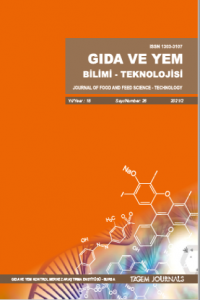Assesing Pistachio Nut (Pistacia vera L.) Adulteration with Green Pea (Pisum sativum L.) by Untargeted Liquid Chromatography-(quadrupole-time of flight)-Mass Spectrometry Method and Chemometrics
Fingerprinting, Pistachio Nut, Green Pea, Parmak İzi, Antep Fıstığı
___
- Araujo, A.S., Rocha, L.L., Tomazela, D.M. Sawaya, A.C. Almeida, R.R. Catharino, R.R. and Eberlin M.N., 2005. Electrospray ionization mass spectrometry fingerprinting of beer. Analyst, 130:884-889.
- Catharino, R.R., Haddad, R. Cabrini, L.G. Cunha, I.B. Sawaya, A.C. and Eberlin, M.N., 2005. Chatacterization of vegetable oils by electrospray ionization mass spectrometry fingerprinting classification quality adulteration and aging. Anal Chem, 77: 7429-7433.
- Catharino, R.R., Cunha, I.B. Fogaça, A.O. Facco, E.M. Godoy, H.T. Daudt, C.E. Eberlin, M.N. and Sawaya, A.C., 2006. Characterization of must and wine of six varieties of grapes by direct infusion electrospray ionization mass spectrometry. J. Mass Spectrom, 41: 185-190.
- Cebi, N., Yilmaz, M.T. and Sagdic, O., 2017. A rapid ATR-FTIR spectroscopic method for detection of sibutramine adulteration in tea and coffee based on hierarchical cluster and principal component analyses. Food Chem, 229:517–526.
- Chylinska, M., Szymanska-Chargot, M. Kruk, B. and Zdunek, A., 2016. Study on dietary by fourier transform-infrared spectroscopy and chemometric methods. Food Chem, 196:114-122.
- Cooper, H.J., Marshall, A.G., 2001.Electrospray Ionization Fourier Transform Mass Spectrometric Analysis of Wine. J. Agric. Food Chem, 49: 5710-5718.
- Guijarro-Díez, M., Castro-Puyana, M. Crego, A.L. and Marina, M.L., 2017. A novel method for the quality control of saffron through the simultaneous analysis of authenticity and adulteration markers by liquid chromatography-(quadrupole-time of flight)-mass spectrometry. Food Chem, 228:403-410.
- Hussain, MA., Dawson. C.O., 2013. Economic Impact of Food Safety Outbreaks on Food Businesses. Foods, 2: 585-589.
- Koçak, H.E., Yılmaz, O. M. and Boyacıoğlu, İ.H., 2016. Detection of green pea adulteration in pistachio nut granules by using Raman hyperspectral imaging. Eur. Food Res. Technol, 242:271-277.
- Koçak, F., Jabeen, F.Ahmed, M. Hussain, J. Al Mashaykhi, S.A.A. Al Rubaiey, Z.A.A. Farooq, S.Boqué, R. Ali, L. Hussain, Z. Al-Harrasi, A. Khan, A.L. Naureen, Z.Idrees, M. and Manzoor, S., 2017. Development of new NIR-spectroscopy method combined with multivariate analysis for detection of adulteration in camel milk with goat milk. Food Chem, 221:746-750.
- Ko, A.Y., Rahman, M.M. Abd El-Aty ,A.M. Jang, J. Choi, J.H. Mamun, M.I.and Shim, J.H., 2014. Identification of volatile organic compounds generated from healthy and infected powdered chili using solvent-free solid injection coupled with GC/MS: Application to adulteration. Food Chem, 156:326–332.
- Nunes Miranda, J.D., Igrejas ,G. Araoj, E.Reboiro-Jato, M. And Capelo, J.L., 2013. Mass spectrometry- based peptides finger printing of proteins in wine quality control: A critical overview. Crit. Rev. Food Sci. Nutr, 53: 751-759.
- Petrakis, E.A., Cagliani, L.R. Polissiou ,M.G. and Consonni, R., 2015. Evaluation of saffron (Crocus sativus L.) adulteration with plant adulterants by 1H NMR metabolite fingerprinting .Food Chem, 173:890–896.
- Petrakis, E.A., Polissiou, M.G., 2017.Assessing saffron (Crocus sativusL.) adulteration with plant-derived adulterants by diffuse reflectance infrared Fourier transform spectroscopy coupled with chemometrics. Talanta, 162:558–566.
- Santos, P.M., Pereira-Filho, E.R. Colnago, L.A ., 2016. Detection and quantification of milk adulteration using time domain nuclear magnetic resonance (TD-NMR). Microchem. J, 124: 15–19.
- Souza ,P.P., Augusti, D.V. Catharino ,R.R. Siebald, H.G.L. Eberlin, M.N.and Augusti, R., 2007. Differentiation of rum and Brazilian artisan cachaça via electrospray ionization mass spectrometry fingerprinting. J. Mass Spectrom, 42: 1294-1299.
- Tay, M., Fang, G. Chia, P.L. and Li, S.F., 2013. Rapid screening for detection and differentiation of detergent powder adulteration in infant milk formula by LC–MS. Forensic Sci. Int, 232: 32-39.
- Tomaino,A., Martorana, M. Arcoraci ,T. Monteleone, D. Giovinazzo, C. And Saija, A., 2010. Antioxidant activity and phenolic profile of pistachio (pistaciavera L. Varietybronte) seeds and skins. Biochimie, 92: 1115-1122.
- Tsantili, E., Takidelli ,C. Christopoulos ,M.V. Lambrinea, E. Rouskas, D. and Roussos, P.A., 2010. Physical, compositional and sensory differences in nuts among pistachio (Pistachia vera L.) varieties. Sci. Hortic,125:562-568.
- Winkler-Moser, J.K., Singh, M. Rennick ,K.A. Bakota, E.L.Jham, G. Liu, S.X. and Vaughn, S.F., 2015. Detection of Corn Adulteration in Brazilian Coffee (Coffea arabica) by Tocopherol Profiling and Near-Infrared (NIR) Spectroscopy. J. Agric. Food Chem, 63: 10662-10668.
- Wu, Z., Rodgers, R.P. and Marshall, A.G., 2004. Characterization of vegetable oils: detailed compositional fingerprints derived from electrospay ionization fourier transform ion cyclotron resonance mass spectrometry. J. Agric. Food Chem, 52: 5322-5328.
- Xu, B., Li, P. Ma, F. Wang, X. Matthäus, B. Chen, R. Yang, Q. Zhang, W. and Zhang, Q., 2015. Detection of virgin coconut oil adulteration with animal fats using quantitative cholesterol by GC _ GC–TOF/MS analysis. Food Chem, 178:128–135.
- Xu, X., Cai, Z. Zhang,J. Chen, Q. Huang, B. and Ren, Y., 2017. Screening of polypeptide toxins as adulteration markers in the food containing wild edible mushroom by liquid chromatography-triple quadrupole mass spectrometry. Food Control, 71: 393-400.
- ISSN: 1303-3107
- Yayın Aralığı: Yılda 2 Sayı
- Başlangıç: 2015
- Yayıncı: Bursa Gıda ve Yem Kontrol Merkez Araştırma Enstitüsü
Peynirde Tuz Oranının*Azaltılmasına Yönelik Alternatif Teknolojiler: Yüksek Basınç Uygulaması (HPP)
Filiz ÇAVUŞ, Murat Faruk US, Nurcan AYSAR GÜZELSOY
Gıda İşlemede Isısal Olmayan Uygulamalar: Vurgulu Elektrik Alan
Fatma Kevser ERAFŞAR, İnci ÇINAR
Antibiyotik Dirençli Staphylococcus aureus ve Gıda Güvenliği Açısından Önemi
Çağla ERDOĞAN, Mihriban KORUKLUOĞLU
İbrahim Emre TOKAT, Dilek CUMBUL, Hakan YAVAŞ, Pınar MANARGA BİRLİK
Gıda İşleme Süreçlerinin Pestisit Kalıntıları Üzerine Etkisi ve İşleme Faktörleri
